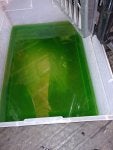Hello everyone, I have some bad news to report and would appreciate some guidance.
I have a VN1600 meanstreak 04.
I purchased the bike two weeks ago, there was a radiator grille cover so I did not catch the previous repairs that had happened with some putty on the bottom of the aluminum radiator near one of the grommets. I saw the the coolant overflow tank was at full so did not worry about coolant when I purchased it.
But I noticed it since... yea probably got screwed but hey it's life I'm moving on.
I decided to take off the radiator to either swap or get it repaired of possible. When I tried to empty it, I did not get a single drop out of the radiator (and yes I opened the cap). This has me quite alarmed, as I took it for an hour long ride about a week ago, most likely with no coolant at all. At the end of the ride the bike started having trouble idling (RPMs went down to about 400 at idle). I still rode it home, and the day after started it back up and it started up well, I fixed a small oil leak I had around a spark plug which I figured may have cause the RPM issue, but I then noticed I was not able to start it back up when it was hot, basically it would only start nicely when cold. That's when I started investigating, and found the coolant leak.
I obviously know I need to change/repair the radiator, but my 2 questions are the following:
1 - Do you think the radiator cap valves are defective since my overflow tank is full but the radiator was empty? Or is it normal that the valves were not pulling in coolant if the radiator had a leak (so basically no pressure buildup).
2 - What are the chances that the engine is damaged from overheating? And what can I do try to tell if it is damaged, compression test?
I would absolutely hate to buy a radiator for 30% of the price I paid for the bike, to then install it and find out I wrecked the engine and I wasted all my efforts and money.
Thanks in advance for your help!
I have a VN1600 meanstreak 04.
I purchased the bike two weeks ago, there was a radiator grille cover so I did not catch the previous repairs that had happened with some putty on the bottom of the aluminum radiator near one of the grommets. I saw the the coolant overflow tank was at full so did not worry about coolant when I purchased it.
But I noticed it since... yea probably got screwed but hey it's life I'm moving on.
I decided to take off the radiator to either swap or get it repaired of possible. When I tried to empty it, I did not get a single drop out of the radiator (and yes I opened the cap). This has me quite alarmed, as I took it for an hour long ride about a week ago, most likely with no coolant at all. At the end of the ride the bike started having trouble idling (RPMs went down to about 400 at idle). I still rode it home, and the day after started it back up and it started up well, I fixed a small oil leak I had around a spark plug which I figured may have cause the RPM issue, but I then noticed I was not able to start it back up when it was hot, basically it would only start nicely when cold. That's when I started investigating, and found the coolant leak.
I obviously know I need to change/repair the radiator, but my 2 questions are the following:
1 - Do you think the radiator cap valves are defective since my overflow tank is full but the radiator was empty? Or is it normal that the valves were not pulling in coolant if the radiator had a leak (so basically no pressure buildup).
2 - What are the chances that the engine is damaged from overheating? And what can I do try to tell if it is damaged, compression test?
I would absolutely hate to buy a radiator for 30% of the price I paid for the bike, to then install it and find out I wrecked the engine and I wasted all my efforts and money.
Thanks in advance for your help!







